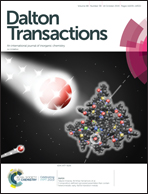A dual-emitting Tb(iii)&Yb(iii)-functionalized coordination polymer: a “turn-on” sensor for N-methylformamide in urine and a “turn-off” sensor for methylglyoxal in serum†
Abstract
Fluorescent materials with lanthanide cations encapsulated in MOFs are currently used in numerous applications, especially in biosensors. Therefore, herein, two novel composites were designed and developed based on a Tb(III)&Yb(III)-functionalized Cu(II)-coordination polymer, possessing higher thermal and water stability and fascinating fluorescence properties. The first bimetallic composite Tb@Cu-Hcbpp demonstrated broad ligand-centered emission and weak typical Tb3+ ion emission; moreover, it was used as an excellent ratiometric fluorescent sensor for the metabolic product NMF of DMF in the human body (LOD = 0.02 μM). In addition, the Yb3+ ions were doped into Tb@Cu-Hcbpp to improve the fluorescence performance of the green Tb3+ ion emission. Among the series of Tb1−xYbx@Cu-Hcbpp samples (x = 0.05, 0.10, 0.15, 0.20, 0.25, 0.30, 0.35 and 0.40), Tb0.85Yb0.15@Cu-Hcbpp showed maximum enhanced fluorescence intensity (almost 9.6 times that of the pure terbium system), but exhibited high fluorescence quenching efficiency for methylglyoxal (MGO), which could be used for the sensitive detection of MGO (LOD = 0.25 μM). Furthermore, the developed biosensors were successfully applied for the detection of NMF and MGO in urine and serum samples, and satisfactory results were obtained, showing good potential of these biosensors in practical applications such as in disease diagnosis and biochemical research.



 Please wait while we load your content...
Please wait while we load your content...